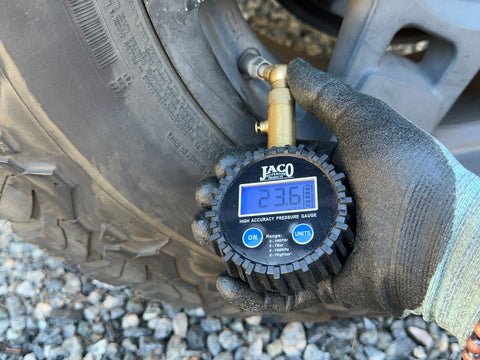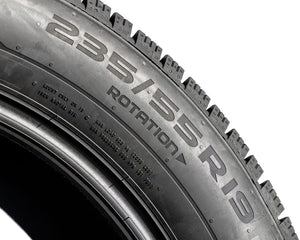
Navigating the Choice Between Analog and Digital Tire Pressure Gauges
In the realm of tire maintenance, ensuring the correct tire pressure isn't merely a suggestion—it's a must-do. But with a myriad of tools at your disposal, how do you decide the most fitting one for your needs? If you've been caught in the crossroads of 'Analog vs Digital Tire Pressure Gauges,' you've come to the right place. This guide is crafted to provide you with a comprehensive comparison, allowing you to understand which gauge is perfect for your tire pressure monitoring routine.
Understanding Analog Tire Pressure Gauges
Analog tire pressure gauges have been a trusted tool for measuring tire pressure for many years. They utilize a mechanical system to provide pressure readings. Here's a closer look at how they work and the pros and cons associated with analog gauges.
Explanation of Analog Tire Pressure Gauges
Analog tire pressure gauges consist of a round dial with a needle indicator and a scale that displays the pressure in PSI (pounds per square inch) or other relevant units. When you press the gauge onto the tire valve stem, the pressure inside the tire compresses a spring within the gauge, causing the needle to move and indicate the pressure on the scale.

Pros and Cons of Analog Gauges
Analog tire pressure gauges have their strengths and limitations. Let's examine the pros and cons associated with using analog gauges:
Accuracy and Precision
One of the advantages of analog gauges is their ability to provide relatively accurate readings. They are designed to measure pressure within a specific range, typically up to 100 PSI. However, it's worth noting that analog gauges may not provide the same level of precision as digital gauges.
Durability and Longevity
Analog gauges are known for their durability and longevity. They are often constructed with robust materials such as metal or heavy-duty plastic, making them resistant to wear and tear. With proper care and maintenance, analog gauges can last for a long time.
Ease of Use and Readability
Many users appreciate the simplicity and user-friendliness of analog gauges. The large dial and clear scale make it easy to read the pressure measurement. Analog gauges also typically feature a pressure-hold function, allowing you to remove the gauge from the valve stem and still read the pressure value.
Factors to Consider When Using Analog Gauges
While analog tire pressure gauges can be reliable, there are a few factors to keep in mind when using them:
Calibration and Zeroing
Analog gauges may require occasional calibration or zeroing to maintain accuracy. Over time, the mechanical components can experience slight shifts or wear, affecting the gauge's readings. It's recommended to check the calibration periodically and make adjustments if necessary.
Maintenance and Care
Proper maintenance is essential to ensure the accuracy and longevity of analog gauges. Regularly clean the gauge and protect it from excessive moisture or extreme temperatures. Additionally, avoid dropping or subjecting the gauge to rough handling, as it can impact its performance.

Exploring Digital Tire Pressure Gauges
Digital tire pressure gauges have gained popularity in recent years due to their advanced technology and ease of use. Let's delve into the world of digital gauges and examine their features and considerations.
Introduction to Digital Tire Pressure Gauges
Digital tire pressure gauges utilize electronic components to measure and display tire pressure. These gauges typically feature an LCD screen that shows the pressure reading in digital format, making it easy to read and interpret.
Advantages and Disadvantages of Digital Gauges
Using digital tire pressure gauges offers several advantages, but it's important to be aware of their limitations as well. Here are some key points to consider:
Accuracy and Precision
Digital gauges are known for their high level of accuracy and precision. They provide readings with greater accuracy compared to analog gauges, often displaying pressure values up to the decimal point. This precision can be particularly beneficial for vehicles with specific tire pressure requirements.
Ease of Use and Readability
Digital gauges are designed for user-friendliness. The digital display provides clear and easy-to-read pressure readings, eliminating the need for interpretation. Additionally, some digital gauges may offer backlighting or larger screens, enhancing readability in low-light conditions.
Additional Features and Functionalities
Digital gauges often come with additional features and functionalities. These can include programmable target pressure settings, automatic shut-off to conserve battery life, and the ability to switch between different pressure units (such as PSI, kPa, or BAR). Some advanced digital gauges may also offer integrated tread depth measurement or flashlight functions.
Factors to Consider When Using Digital Gauges
While digital tire pressure gauges offer convenience and accuracy, it's important to consider a few factors when using them:
Battery Life and Replacement
Since digital gauges rely on batteries for operation, it's essential to monitor the battery life. Some gauges feature long-lasting batteries, while others may require more frequent replacements. It's a good practice to carry spare batteries or opt for rechargeable digital gauges.
Sensitivity to Extreme Temperatures
Extreme temperatures, whether extremely hot or cold, can affect the performance of digital gauges. It's important to store and use digital gauges within the specified temperature range provided by the manufacturer. Exposing them to extreme conditions can impact their accuracy and functionality.

Choosing the Right Gauge for Your Needs
Assessing Your Preferences and Requirements
When it comes to selecting a tire pressure gauge, it's important to consider your personal preferences and specific requirements. Ask yourself questions such as:
- What level of accuracy do I need?
- Do I prefer a traditional analog gauge or a modern digital one?
- Are additional features, such as backlighting or programmable settings, important to me?
- How frequently will I be using the gauge?
By understanding your preferences and requirements, you can narrow down your options and make an informed decision.
Comparing the Pros and Cons of Analog and Digital Gauges
Both analog and digital tire pressure gauges have their advantages and disadvantages. Let's compare them side by side:
Analog Gauges
-
Pros:
- Straightforward operation and no battery dependency
- Generally durable and less prone to damage
- Lower initial cost compared to digital gauges
-
Cons:
- Less precise and may require interpretation of the scale
- Readability may be affected in low-light conditions
- Not equipped with additional features found in digital gauges
Digital Gauges
-
Pros:
- High accuracy and precision with easy-to-read digital displays
- Additional features such as programmable settings and backlighting
- Some models offer integrated tread depth measurement
-
Cons:
- Battery dependency and potential need for replacements
- Readability can be affected in extreme temperatures or conditions
- Typically higher initial cost compared to analog gauges

Considering Factors Such as Accuracy, Ease of Use, Durability, and Additional Features
When choosing between analog and digital gauges, consider the following factors:
- Accuracy: If precise measurements are crucial, digital gauges may be a better choice.
- Ease of Use: Digital gauges provide instant readings without the need for interpretation, while some individuals may prefer the simplicity of analog gauges.
- Durability: Analog gauges are generally known for their durability and resistance to damage, while digital gauges may be more sensitive to extreme conditions.
- Additional Features: If you value features like programmable settings or integrated tread depth measurement, digital gauges offer more options.
Budget Considerations and Value for Money
Finally, consider your budget when selecting a tire pressure gauge. While analog gauges tend to have a lower initial cost, digital gauges offer advanced features and precision at a higher price point. Assess the value for money by weighing the features , durability, and accuracy that align with your needs.
Remember, investing in a reliable and accurate tire pressure gauge is an essential part of maintaining your vehicle's performance and safety.
Best Practices for Using Tire Pressure Gauges
Importance of Proper Technique When Using Gauges
Using a tire pressure gauge correctly is vital to obtain accurate readings. Proper technique ensures that you can identify any deviations from the recommended tire pressure and take appropriate action. Here are some key points to keep in mind:
- Ensure the gauge is calibrated and zeroed before each use.
- Place the gauge firmly onto the valve stem to prevent air leakage.
- Hold the gauge steady and wait for the reading to stabilize.
- Record the measurements for all tires and compare them to the manufacturer's recommended pressure.
By following these steps, you can rely on precise readings and maintain optimal tire pressure.
Step-by-Step Guide for Accurate Tire Pressure Measurements
Here's a step-by-step guide to help you measure tire pressure accurately:
- Remove the valve cap from the tire's valve stem.
- Press the tire pressure gauge firmly onto the valve stem.
- Ensure a tight seal to prevent air leakage.
- Read the pressure measurement displayed on the gauge.
- Compare the reading to the recommended pressure specified by the vehicle manufacturer.
- If the pressure is too low, add air until it reaches the correct level. If it's too high, release air until the desired pressure is achieved.
- Repeat the process for each tire.
- Replace the valve caps securely once you have finished.
By following these steps, you can confidently maintain the correct tire pressure for optimal vehicle performance and safety.
Maintenance Tips to Ensure Gauge Performance and Longevity
To ensure the performance and longevity of your tire pressure gauge, consider these maintenance tips:
- Store the gauge in a clean and dry place to prevent dust or moisture buildup.
- Regularly inspect the gauge for any signs of damage or wear.
- Keep the gauge away from extreme temperatures or direct sunlight.
- If your gauge has a replaceable battery, monitor the battery life and replace it when necessary.
- Periodically calibrate the gauge to maintain accuracy, following the manufacturer's instructions.
By following these maintenance practices, you can ensure that your tire pressure gauge remains reliable and provides accurate readings over time.

Recommended Tire Pressure Gauges
Best Analog Tire Pressure Gauges
When it comes to analog tire pressure gauges, the following options stand out for their reliability and accuracy:
- JACO ElitePro Tire Pressure Gauge - 100 PSI
- JACO FlowPro Tire Inflator with Pressure Gauge - 100 PSI
- JACO Elite Tire Pressure Gauge - 100 PSI
These analog gauges are designed to provide precise measurements and are built to last, ensuring you can maintain proper tire pressure consistently.
Best Digital Tire Pressure Gauges
If you prefer digital tire pressure gauges, consider these top choices:
- JACO ElitePro Digital Tire Pressure Gauge - 100 PSI
- JACO Elite Digital Tire Pressure Gauge - 100 PSI
- JACO FlowPro Digital Tire Inflator with Pressure Gauge - 200 PSI
These digital gauges offer the convenience of easy-to-read digital displays and additional features for enhanced functionality.
Features and Benefits
Both analog and digital gauges from JACO provide exceptional quality and performance. Here are some key features and benefits:
- Precision: Accurate measurements ensure proper tire pressure.
- Durability: Sturdy construction for long-lasting use.
- Readability: Clear displays for easy reading of pressure readings.
- Additional Features: Some digital gauges offer features like backlighting, pressure relief valves, and the option to connect inline to an air compressor for tire inflation.
Whether you prefer the classic analog gauge or the modern digital option, JACO gauges deliver reliable results and make tire pressure maintenance hassle-free.
When choosing a tire pressure gauge, consider your personal preferences and requirements. Explore the features of each recommended gauge and select the one that best suits your needs.
By investing in a high-quality tire pressure gauge, you can ensure accurate readings and maintain optimal tire pressure for improved safety and performance.
Final Thoughts
In summary, understanding the differences between analog and digital tire pressure gauges is essential for making an informed decision when it comes to maintaining your vehicle's tire pressure. Here are the key takeaways from this discussion:
- Tire pressure plays a crucial role in vehicle safety and performance, making the use of a reliable tire pressure gauge vital.
- Analog tire pressure gauges offer durability and simplicity, while digital gauges provide precise readings and additional features.
- Consider factors such as accuracy, ease of use, durability, and budget when choosing the right gauge for your needs.
- Proper technique and regular maintenance are essential for ensuring accurate measurements and prolonging gauge lifespan.
Remember, accurately measuring your tire pressure is crucial for optimal safety and performance. By choosing a reliable tire pressure gauge and incorporating regular pressure checks into your maintenance routine, you can ensure that your tires are properly inflated at all times.
So, whether you prefer the traditional analog gauge or the modern digital gauge, take the time to select the one that best suits your needs. Don't overlook the importance of proper tire pressure—it's an investment in your safety and the longevity of your tires.
Take control of your tire pressure and enjoy a smooth, safe, and efficient driving experience!





